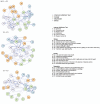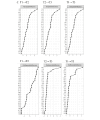The Longitudinal Effect of Psychological Distress on Internet Addiction Symptoms Among Chinese College Students: Cross-Lagged Panel Network Analysis
- PMID: 40315013
- PMCID: PMC12084773
- DOI: 10.2196/70680
The Longitudinal Effect of Psychological Distress on Internet Addiction Symptoms Among Chinese College Students: Cross-Lagged Panel Network Analysis
Abstract
Background: There is a growing amount of evidence suggesting high rates of co-occurring internet addiction (IA) symptoms and psychological distress in youth. However, the extent to which IA symptoms develop over time, how they interact with psychological distress symptoms dynamically, and how they predict one another remain unclear. Additionally, what specific types of distress, including depression, anxiety, and stress, are more closely associated with IA symptoms remains inconclusive.
Objective: This longitudinal study aimed to explore the development of and changes in IA symptoms over time and the directional relationship between IA and various psychological distress symptoms.
Methods: This study followed a sample of 2497 Chinese college students (mean age 19.14, SD 0.72 years) across 3 waves of a data collection span of 2 years. Their IA and psychological distress symptoms were assessed at baseline (T1), 12-month follow-up (T2), and 24-month follow-up (T3). We used network analysis to examine the network structure of IA symptoms at each wave and cross-lagged panel network (CLPN) analysis to investigate longitudinal associations between IA symptoms and psychological distress, including depressive, anxiety, and stress symptoms.
Results: The cross-sectional networks of IA symptoms at 3 time points showed high similarity in terms of structure, existence of edges, and centrality indices. Nodes A2 (excessive use), A1 (salience), and A5 (lack of control) emerged as nodes with the highest expected influence (EI) centrality in the IA symptom networks across time (A2: EI=1.13 at T1, 1.15 at T2, 1.17 at T3; A1: EI=1.10 at T1, 1.13 at T2, 1.15 at T3; A5: EI=0.86 at T1, 0.88 at T2, 0.92 at T3). CLPN analysis revealed that psychological distress predicts IA symptoms but not the other way around. Depressive symptoms played a key role in predicting various IA-related problems (T1 to T2, edge weight=0.11; T2 to T3, edge weight=0.28; T1 to T3, edge weight=0.22) and served as bridge symptoms connecting IA and psychological distress (T1 to T2: bridge-expected influence [BEI]=0.15; T2 to T3: BEI=0.14; T1 to T3: BEI=0.19).
Conclusions: Findings revealed a relatively stable network structure of IA symptoms among college students and suggested that psychological distress, especially depressive symptoms, may play a central role in activating IA symptoms over time. These results provide evidence for understanding the directional relationship between the central characteristics of distress symptoms and IA. The study also underscores the importance of depressive symptoms in their co-occurrence with IA, indicating that the key and bridge symptoms identified in this study can be prioritized as targets for preventing and treating IA in Chinese youth. Through identification and early intervention of depressive symptoms, we may avoid the progression of co-occurring issues, leading to more effective treatment outcomes.
Keywords: anxiety; college students; cross-lagged panel network analysis; depression; internet addiction; network analysis; psychological distress; stress.
©Yuxuan Jiang, Chuman Xiao, Xiang Wang, Dongling Yuan, Qian Liu, Yan Han, Jie Fan, Xiongzhao Zhu. Originally published in the Journal of Medical Internet Research (https://www.jmir.org), 02.05.2025.
Conflict of interest statement
Conflicts of Interest: None declared.
Figures




Similar articles
-
A cross-lagged panel network model on internet gaming disorder and depressive symptoms concerning preferences for game genres.J Affect Disord. 2025 Apr 15;375:27-34. doi: 10.1016/j.jad.2025.01.006. Epub 2025 Jan 13. J Affect Disord. 2025. PMID: 39814188
-
Longitudinal Associations between Healthy Eating Habits, Resilience, Insomnia, and Internet Addiction in Chinese College Students: A Cross-Lagged Panel Analysis.Nutrients. 2024 Jul 30;16(15):2470. doi: 10.3390/nu16152470. Nutrients. 2024. PMID: 39125349 Free PMC article.
-
Protective and risk factors in problematic mobile phone use among adolescents: A three-wave longitude study.Addict Behav. 2025 Jun;165:108299. doi: 10.1016/j.addbeh.2025.108299. Epub 2025 Feb 16. Addict Behav. 2025. PMID: 39970598
-
Effects of exercise interventions on Internet addiction among college students: A systematic review and meta-analysis of randomized controlled trials.Addict Behav. 2025 Jan;160:108159. doi: 10.1016/j.addbeh.2024.108159. Epub 2024 Sep 17. Addict Behav. 2025. PMID: 39303655
-
The Association between Moral Intelligence and Communication Skills with Internet Addiction: The Mediating Role of Psychological Distress in Secondary School Students of Tabriz, Iran.J Caring Sci. 2024 Sep 29;14(1):42-51. doi: 10.34172/jcs.025.33745. eCollection 2025 Feb. J Caring Sci. 2024. PMID: 40391314 Free PMC article. Review.
Cited by
-
Unveiling Diverse Trajectories of Internet Addiction and the Influence of Family Environment and Obsessive Beliefs: Multi-Wave Longitudinal Study With Growth Mixed Model.J Med Internet Res. 2025 Jul 23;27:e70552. doi: 10.2196/70552. J Med Internet Res. 2025. PMID: 40699882 Free PMC article.
References
-
- Saunders JB, Hao W, Long J, King DL, Mann K, Fauth-Bühler M, Rumpf H, Bowden-Jones H, Rahimi-Movaghar A, Chung T, Chan E, Bahar N, Achab S, Lee HK, Potenza M, Petry N, Spritzer D, Ambekar A, Derevensky J, Griffiths MD, Pontes HM, Kuss D, Higuchi S, Mihara S, Assangangkornchai S, Sharma M, Kashef AE, Ip P, Farrell M, Scafato E, Carragher N, Poznyak V. Gaming disorder: its delineation as an important condition for diagnosis, management, and prevention. J Behav Addict. 2017 Sep 01;6(3):271–279. doi: 10.1556/2006.6.2017.039. - DOI - PMC - PubMed
-
- Li L, Xu D, Chai J, Wang D, Li L, Zhang L, Lu L, Ng CH, Ungvari GS, Mei S, Xiang Y. Prevalence of Internet addiction disorder in Chinese university students: a comprehensive meta-analysis of observational studies. J Behav Addict. 2018 Sep 01;7(3):610–623. doi: 10.1556/2006.7.2018.53. https://europepmc.org/abstract/MED/30010411 - DOI - PMC - PubMed
-
- Shao Y, Zheng T, Wang Y, Liu L, Chen Y, Yao Y. Internet addiction detection rate among college students in the People's Republic of China: a meta-analysis. Child Adolesc Psychiatry Ment Health. 2018 May 25;12(1):25. doi: 10.1186/s13034-018-0231-6. https://capmh.biomedcentral.com/articles/10.1186/s13034-018-0231-6 231 - DOI - DOI - PMC - PubMed
MeSH terms
LinkOut - more resources
Full Text Sources
Medical

